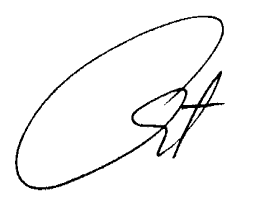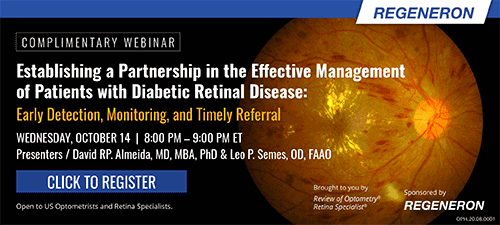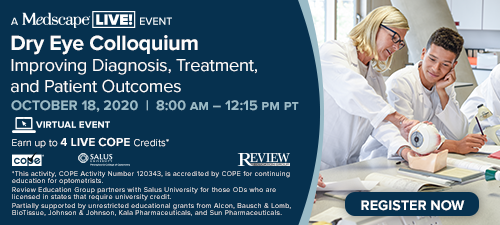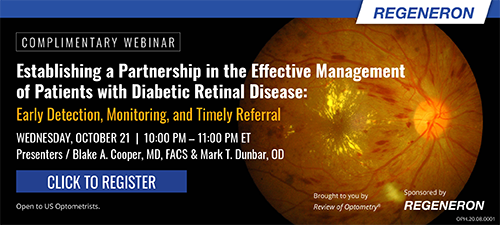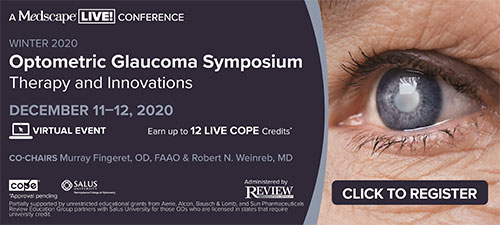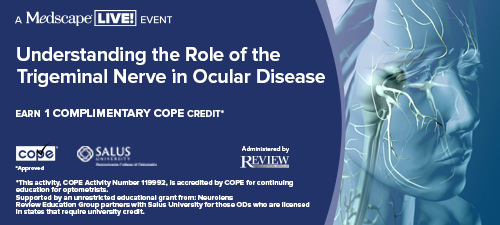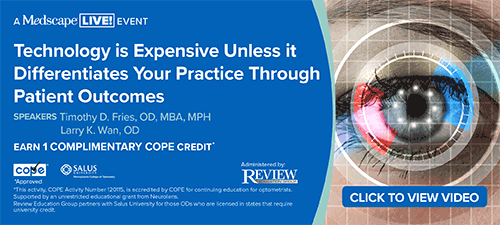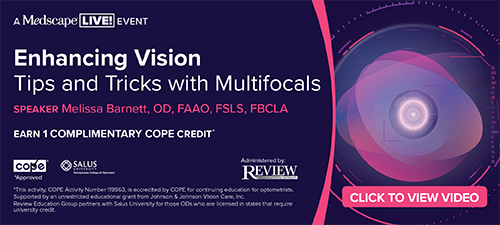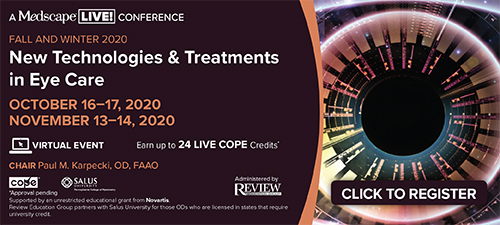
A
weekly e-journal by Art Epstein, OD, FAAO
Off the Cuff: Why I am Enthused About the Infuse
Okay, call me a geek. As kids, my brother and I played with my dad’s college chemistry set and nearly blew the house up. We had a Zeiss microscope passed down from my uncle, and I was the only kid on my block, maybe in the entire Bronx, who knew what a thistle tube was. We watched Mr. Wizard every Saturday morning religiously. As I got older, I’d first fix and eventually build my own radios. In college, I was a psych major, but oddly, I liked organic chemistry. I loved the idea of creating things and understanding how I created them. While I thought that, like most things in college, all of that chemistry would be of limited value in the real world, I was wrong. While it may sound weird, I am fascinated by contact lens solutions. I read the labels on artificial tears. I can listen to talks on contact lens material engineering for hours and Otto Wichterle, the father of hydrogel materials and inventor of the soft lens, is a personal hero. I have had the good fortune of a career surrounded by brilliant teachers and mentors like Ralph Stone, PhD, former head of R&D at Alcon, one of the foremost experts on contact lens solutions. I’ve been inspired and tutored by George Grobe, PhD, vice president of B+L R&D, who I first met on the top of the World Trade Center where he and Jay Künzler described how they engineered the surface of the first silicone hydrogel lens, B+L’s PureVision. Amazing how 20 years goes by in a blink of an eye. More recently, I’ve gotten to work closely with Drs. Grobe, Dan Hook, Bill Reindel and other members of Bausch + Lomb’s incredibly innovative R&D team. I want to share a bit about how B+L developed its latest contact lens, the Infuse Silicone Hydrogel One Day, and the science behind it. I find it inspirational and I think you will too. While most contact lenses are the work of polymer and surface chemists who labor in relative isolation behind laboratory doors, B+L’s Infuse is the first contact lens actually inspired by the natural engineering of the ocular surface environment. If you’ve heard me speak about dry eye and the ocular surface over the past few years, you’ve heard about the critical importance of homeostasis in maintaining ocular surface health and function. The Infuse combines a next-generation silicone hydrogel material with high Dk, low modulus, UV inhibition, optimized aspheric optics and innovative chemistry to minimize impact on the ocular surface while maintaining delicate homeostatic balance. What B+L refers to as ProBalance Technology reads like the package insert of a state-of-the-art artificial tear, and dramatically improves comfort. This didn’t happen by accident. Bausch consulted experts in dry eye and OSD to better understand how lenses cause homeostatic imbalance and then designed and implemented strategies to overcome it. The lens was engineered from the eye up.
|
|||||
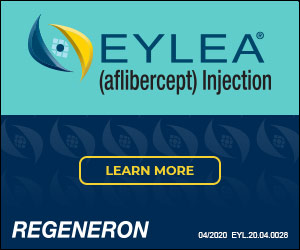 |
||
| Myopia, or Near-sightedness, is Associated with Delayed Melatonin Circadian Timing and Lower Melatonin Output in Young Adult Humans | ||||
Myopia, or near-sightedness, is the most common refractive vision disorder and predisposes the eye to many blinding conditions in adulthood. Recent research has suggested that myopia is associated with increased endogenous melatonin production. Researchers investigated the differences in melatonin circadian timing and output in young adult myopes and non-myopes (or emmetropes) as a pathogenesis for myopia. Eighteen myopic (refractive error [mean ± standard deviation] -4.89 ± 2.16D) and 14 emmetropic participants (-0.09 ± 0.13D), ages 22.06 ± 2.35 years were recruited. Circadian timing was assessed using salivary dim light melatonin onset, collected half-hourly for seven hours, beginning five hours before and finishing two hours after individual average sleep onset in a sleep laboratory. Total melatonin production was assessed via aMT6s levels from urine voids collected from 6 pm and until wake-up time the following morning. Objective measures of sleep timing were acquired for a week prior to the sleep laboratory visit using an actigraphy device. Myopes (22:19 ± 1.8 hours) exhibited a dim light melatonin onset phase-delay of 1 hour 12 minutes compared with emmetropes (21:07 ± 1.4 hours), p=0.026, d = 0.73. Urinary aMT6s melatonin levels were significantly lower among myopes (29.17 ± 18.67) than emmetropes (42.51 ± 23.97, p=0.04, d=0.63). Myopes also had a significant delay in sleep onset, greater sleep onset latency, shorter sleep duration and more evening-type diurnal preference than emmetropes (all p<0.05). |
||||
SOURCE: Chakraborty R, Micic G, Thorley L, et al. Myopia, or near-sightedness, is associated with delayed melatonin circadian timing and lower melatonin output in young adult humans. Sleep. 2020; Oct 8. [Epub ahead of print]. |
||||
 |
||
| Conjunctival Prolapse During Open Eye Scleral Lens Wear | ||||
To investigate the incidence and peak elevation of conjunctival prolapse during short-term open eye scleral lens wear and its association with lens fitting characteristics,
10 young, healthy adults (mean age ± SD, 30 ± 4 years) wore a high Dk sealed scleral lens for 90 minutes with an initial central post-lens fluid reservoir thickness defined as low (144 ± 23 μm), medium (487 ± 63 μm) and high (726 ± 55 μm). Optical coherence tomography was used to quantify limbal clearance, lens settling and changes in conjunctival thickness.
|
||||
SOURCE: Fisher D, Collins MJ, Vincent SJ. Conjunctival prolapse during open eye scleral lens wear. Cont Lens Anterior Eye. 2020; Oct 2:S1367-0484(20)30169-7. |
||||
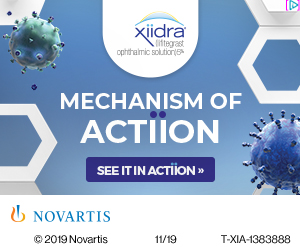 |
||
| The Relationship Between Vision and Comfort in Contact Lens Wear | ||||
Investigators conducted a retrospective analysis of five trials using similar protocols with non-presbyopic (NP) myopes or presbyopic participants (Px) wearing various simultaneous-image designs (SM) and single-vision (SV) CL (NP only). Questionnaires (vision satisfaction, vision clarity: distance/intermediate/near, comfort) on one to 10 scale were administered one week after fitting. The vision/comfort relationship was analyzed using linear mixed model and presented as regression coefficient with 95% confidence intervals (CIs). Vision ratings correlated with comfort ratings, although this varied depending on type of vision rating and Px category. Vision satisfaction influenced comfort for the NP-SV group (slope: 0.8; 95% CI: 0.58 to 1.01, p≤0.001), but was significantly lower in the presbyopic group (slope: 0.38; 95% CI: 0.33 to 0.42; p≤0.001). Controlling for lens material obtained similar results. In the reverse relationship, comfort had a significant impact on vision satisfaction, although again at varying levels for each Px group. NP-SV demonstrated the weakest relationship (slope: 0.47; 95% CI: 0.35 to 0.59, p≤0.001) in comparison with NP-SM and P-SM groups. Vision and comfort in CL wear were inter-related. Investigators wrote that consideration of Px characteristics, visual stimulus and CL comfort need to be accounted for when assessing overall CL experience. |
||||
SOURCE: Diec J, Naduvilath T, Tilia D, et al. The relationship between vision and comfort in contact lens wear. eye contact lens. 2020; Sep 29. [Epub ahead of print]. |
||||
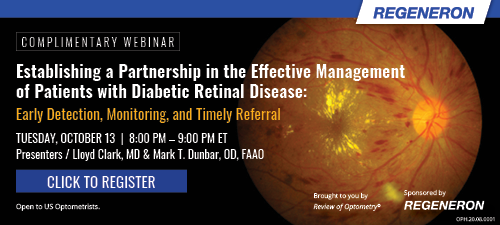 |
||
| News & Notes | ||||||||
| J&J Vision Presents Myopia Research & New Findings on CL Wearers with Dry Eye, at Academy 2020; Survey: Most People Acknowledge Importance of Annual Exams Though They’re Not Getting One At the American Academy of Optometry's virtual annual meeting Johnson & Johnson Vision researchers are announcing the company’s latest myopia research and revealing findings that demonstrate how Acuvue Oasys 1-Day with Hydraluxe Technology Contact Lenses reduced dry eye symptoms in contact lens wearers who are symptomatic in their habitual lens wear. An integrated retrospective analysis of three trials including 107 symptomatic dry eye contact lens patients revealed a clinically meaningful and statistically significant (p<0.0001) difference in comfort when wearers switched to Acuvue Oasys 1-Day with Hydraluxe Technology Contact Lenses. Read more. In addition, the company announced findings from a global eye health survey revealing a disconnect in patient views towards the importance of eye health, as well as barriers to care, and varying attitudes towards eye health specific to regions, generations and genders. Most adults surveyed (80%) said they viewed an eye exam as important for their overall health, and recognized that healthy vision improves overall quality of life (68%) and keeps them safe (61%). However, less than half (46%) of all respondents said they get an eye exam each year. The results were released in advance of World Sight Day on October 8. Learn more.
|
||||||||
| Allergan Announces Refresh Concierge Program for ECPs Allergan, an AbbVie company, is providing eye care professionals with tools to assist with patient education, engagement and product accessibility—even when patients can't make it to the practice in person. The company’s Refresh Concierge is a full-service, dedicated remote support team providing eye care professionals with patient coupons, product education, help creating a Refresh Direct eCommerce online store and access to samples of Refresh products. Learn more.
|
||||||||
| Walman University is Back Virtually Walman Optical is offering a free virtual event, Walman University, Oct. 17 to all in the eyecare industry. Industry experts Phernell Walker and Mike Karlsrud will live stream courses worth up to six ABO, NCLE or CPO credits. Specifically, technical courses by Master Optician Walker will address prism, diabetic retinopathy and advancements in optical technology, while interactive sessions by Mike Karlsrud will provide strategies to develop effective communication, and inspire and motivate staff. Register here.
|
||||||||
| Volk’s VistaView Retinal Camera Streamlines Image Management Volk Optical’s new VistaView portable mydriatic retinal camera integrates the company’s high-resolution, all-glass, double aspheric optics with an intuitive digital platform to capture sharp, widefield fundus images while managing patient data on the device. The all-in-one device offers an onboard app featuring image review, enhancement and analysis, and instant password-protected report generation and transmittal. Learn more.
|
||||||||
| IDOC Partners with United Eye Care Providers IDOC launched a professional partnership with Illinois-based United Eye Care Providers, an alliance of private practice optometrists. Next month, UECP, in collaboration with IDOC, will host two virtual CE sessions focused on a condition frequently encountered by eye care professionals on the front lines of patient care. Nov. 18, Dr. Jeffry Gerson will discuss the diagnosis and treatment of diabetes-related issues, and Nov. 19, Dr. April Jasper will present new findings on glaucoma screening and treatment protocols. Learn more.
|
||||||||
Positive Data Released on Phase III Trials of Upneeq for Acquired Ptosis RVL Pharmaceuticals announced JAMA Ophthalmology published pooled analysis of data from two Phase III clinical trials of Upneeq (oxymetazoline hydrochloride ophthalmic solution) 0.1% for treatment of acquired blepharoptosis in adults showing the treatment was associated with positive outcomes after instillation on days one and 14, and was well-tolerated. Upneeq, a novel pharmacologic agent, is approved by the FDA for the treatment of ptosis. The preservative-free eye drop administered once daily to ptotic eye(s). Read more.
|
||||||||
Nielsen's BASES Names LUMIFY Eye Drops to Top 25 Breakthrough Innovations Bausch + Lomb announced that BASES, a Nielsen Global Consumer business division, named LUMIFY (brimonidine tartrate ophthalmic solution 0.025%) redness reliever eye drops to its 2020 U.S. BASES Top 25 Breakthrough Innovations List in the superstar category for its success in driving sales and category growth. Read more.
|
||||||||
|
||||||||
|
||||||||
|
||||||||
|
Optometric Physician™ (OP) newsletter is owned and published by Dr. Arthur Epstein. It is distributed by the Review Group, a Division of Jobson Medical Information LLC (JMI), 19 Campus Boulevard, Newtown Square, PA 19073. HOW TO ADVERTISE |

